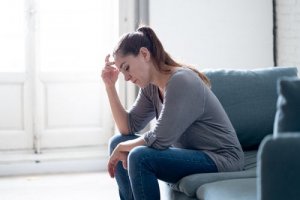Physical Pain and Anxiety, and Their Relationship

Physical pain and anxiety are symptoms that often go hand in hand. According to a report by the American Psychiatric Association at their 161st Congress, 60% of patients with anxiety also suffer from physical pain. In addition, there’s also depression in 80% of these cases. In another study in the Journal of Affective Disorders, researchers show that 78% of people with psychological problems also develop organic symptoms, including physical pain. Even though the figures are evidence in themselves, estimates indicate that in 60% of the consultations doctors fail to establish the link between physical pain and anxiety. This is because a compartmentalized approach predominates, in which they address physical and mental symptoms separately. Anxiety, a widespread problem [image src=’https://steptohealth.com/wp-content/uploads/2020/01/A-woman-leaning-against-a-wall..png’]A woman leaning against a wall.[/image] Anxiety is currently a very common problem in the population. And, even though it involves emotional disorders, it also has to do with physical symptoms. Thus, anxiety is an unpleasant state that virtually all people experience, at least momentarily, at some point in their lives. This is because it’s a response to stimuli perceived as threatening. Sometimes these stimuli are real risks and other times they correspond to perceived or imaginary risks. Excessive simultaneous stimuli also lead to anxiety. Some believe that living in big cities has a high potential of generating anxiety. These environments imply successive states of alert that together generate stress and, ultimately, anxiety. There’s an imprecise fear when it comes to anxiety, which leads to us creating defensive behaviors. Under this state, there are also organic changes, such as increased heart rate, sweating, and agitated breathing. Obviously, these physiological changes will alter the functioning of our bodies over time. Read also: Post Traumatic Stress and its Effects on Your Body A study on physical pain and anxiety A study that included 1,317 patients, in 80 health centers, published by the General Council of Psychology, shows that 981 of the patients had some level of anxiety. They established that 59% of patients with anxiety also had physical pain. It’s clear that there’s a close correlation between anxiety and physical pain, but the percentage increased by 19% if there was also depression. The most worrying thing is that, of all of them, only 17% received some type of treatment for their psychological problems. Many patients have physical pain that doctors can’t find an organic explanation for. Thus, pain ends up becoming the way that some people express their emotional suffering. However, not all doctors admit or recognize this correlation. Physical pain and anxiety [image src=’https://steptohealth.com/wp-content/uploads/2020/01/A-woman-in-pain.-1.jpg’]A woman in pain.[/image] Anxiety can lead to muscle aches, headaches, stomach symptoms, and other physical discomforts and a professional should evaluate them. Typically, people with anxiety suffer from headaches, muscle aches, stomach and chest pain. Let’s see why. Muscle pains. Anxiety causes muscles to tense. If this remains more or less constant, it leads to muscle pain, as well as a feeling of overload and muscle contractions. Most commonly, these pains accumulate in the back and the neck. Headaches. This pain is a kind of helmet that covers the head and presses against it. It’s also common for there to be a tingling or a pricking sensation happening in the skull. This is a tension headache caused by the contraction of the scalp and neck muscles. Stomach pains. Agitated breathing can produce gases and nervous states also alter digestion. It’s common for many people with anxiety to experience stomach pain. Chest pains. Many people also experience pain in their chests. This causes great uncertainty and may increase anxiety but it’s just a muscular, non-cardiac problem. Don’t miss: Fifteen Ways to Deal with Anxiety What to do? The most important thing is to admit that we’re all exposed to anxiety, to some extent. For this reason, we must adopt lifestyles that allow us to find places for relaxation and recreation. Much more if we experience physical pain and anxiety. Physical exercise is one of the most effective means of restoring the balance of our emotions. A small exercise routine, 15 minutes a day is usually enough to make us feel better. Even better if you combine it with some relaxation practices. In cases where anxiety is excessive, you must consult with a mental health professional. There are many therapies and techniques that can help you manage emotions appropriately. https://steptohealth.com/physical-pain-and-anxiety-and-their-relationship/
All cited sources were thoroughly reviewed by our team to ensure their quality, reliability, currency, and validity. The bibliography of this article was considered reliable and of academic or scientific accuracy.
- Queraltó, J. M. (2005). Análisis de los factores psicológicos moduladores del dolor crónico benigno. Anuario de psicología/The UB Journal of psychology, 36(1), 37-60.
- Lumley MA, Cohen JL, Borszcz GS, et al. Pain and emotion: a biopsychosocial review of recent research. J Clin Psychol. 2011;67(9):942–968. doi:10.1002/jclp.20816
- Anderson E, Shivakumar G. Effects of exercise and physical activity on anxiety. Front Psychiatry. 2013;4:27. Published 2013 Apr 23. doi:10.3389/fpsyt.2013.00027
- Sheng J, Liu S, Wang Y, Cui R, Zhang X. The Link between Depression and Chronic Pain: Neural Mechanisms in the Brain. Neural Plast. 2017;2017:9724371. doi:10.1155/2017/9724371
- de Heer EW, Gerrits MM, Beekman AT, et al. The association of depression and anxiety with pain: a study from NESDA [published correction appears in PLoS One. 2014;9(12):e115077]. PLoS One. 2014;9(10):e106907. Published 2014 Oct 15. doi:10.1371/journal.pone.0106907
- Woo AK. Depression and Anxiety in Pain. Rev Pain. 2010;4(1):8–12. doi:10.1177/204946371000400103
- Psicólogos, C. (2008). DOLOR FÍSICO ASOCIADO A TRASTORNOS COMO LA ANSIEDAD Y LA DEPRESIÓN – INFRADIAGNÓSTICO E INFRATRATAMIENTO EN ATENCIÓN PRIMARIA. Retrieved 9 August 2020, from http://www.infocop.es/view_article.asp?id=1897
This text is provided for informational purposes only and does not replace consultation with a professional. If in doubt, consult your specialist.








